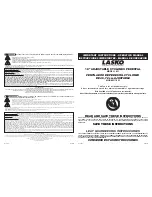
© Munters AB, 2013
19
To avoid excessive voltage drop, which can be harmful to electrical motors, care must be taken as to the thickness
of cables used as well as the distance (D) from the main electrical enclosure to the motor. In the Table below are
the maximum allowable distances.
Motor
Phases
Frequency
[Hz]
Voltage
[V]
Speed
Current
[A]
Cross selectional area of cable
1.5mm
2
2.5mm
2
4mm
2
Maximum allowable lenght: D [m]
2.0hp/
1.5kW
3
3
50/60
50/60
230
400
single
single
6.1
3.5
50
90
90
150
140
240
1.0hp/
0.75kW
1
1
3
3
50
60
50/60
50/60
200-230
208-230
230
400
single/multi
single
single/multi
single/multi
5.2
5.6
4.3-3.8
2.5-2.2
60
50
90
280
100
90
150
460
160
140
240
730
0.75hp/
0.55kW
1
1
3
3
3
3
50
60
50/60
50/60
50/60
50/60
200-230
208-230
230
400
230
400
single/multi
single
single
single
multi
multi
4.5
4.4
2.8
1.6
2.9-2.4
1.65-1.4
80
70
110
350
80
260
130
120
190
580
140
440
210
190
300
920
220
700
0.5hp/
0.37kW
1
1
3
3
3
3
50
60
50/60
50/60
50/60
50/60
200-230
208-230
230
400
230
400
single/multi
single
single
single
multi
multi
3.0
2.9
2.3
1.3
2.4-1.9
1.4-1.1
100
90
140
430
100
320
170
160
230
710
170
540
280
250
360
1,130
280
860
Standard fan motors have the following voltage and frequency:
230/400V three-phase 50 or 60 Hz.
Failure to operate the fan with an overload protection device will render the
motor guarantee null and void. Such motor overload protection devices can be
ordered from Munters and be supplied with the fans.
note
The connection cable must be completely extracted from the fan housing in order
to avoid being damaged by moving parts.
Warning
!
Installation
Chapter5
















































